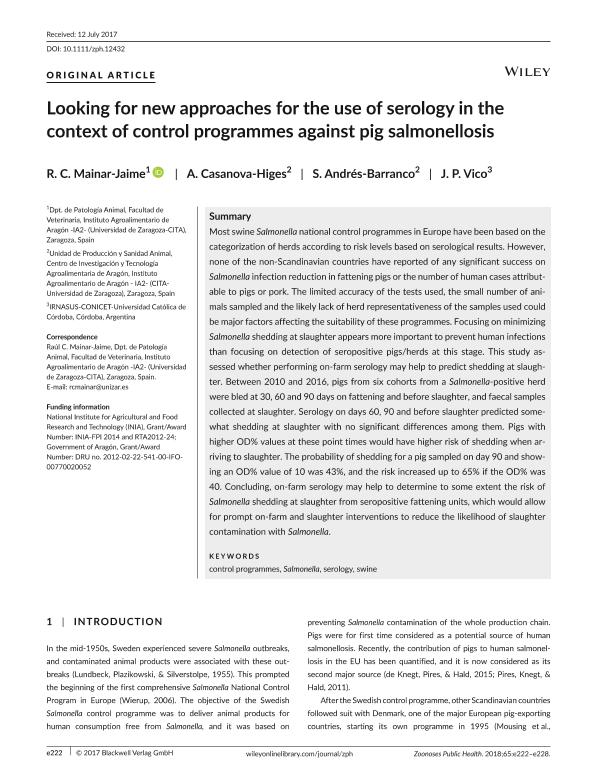Mostrar el registro sencillo del ítem
dc.contributor.author
Mainar-Jaime, R.C.
dc.contributor.author
Casanova-Higes, A.
dc.contributor.author
Andrés-Barranco, S.
dc.contributor.author
Vico, Juan Pablo

dc.date.available
2018-11-16T15:03:18Z
dc.date.issued
2018-02
dc.identifier.citation
Mainar-Jaime, R.C.; Casanova-Higes, A.; Andrés-Barranco, S.; Vico, Juan Pablo; Looking for new approaches for the use of serology in the context of control programmes against pig salmonellosis; Wiley Blackwell Publishing, Inc; Zoonoses and Public Health; 65; 1; 2-2018; e222-e228
dc.identifier.issn
1863-1959
dc.identifier.uri
http://hdl.handle.net/11336/64588
dc.description.abstract
Most swine Salmonella national control programmes in Europe have been based on the categorization of herds according to risk levels based on serological results. However, none of the non-Scandinavian countries have reported of any significant success on Salmonella infection reduction in fattening pigs or the number of human cases attributable to pigs or pork. The limited accuracy of the tests used, the small number of animals sampled and the likely lack of herd representativeness of the samples used could be major factors affecting the suitability of these programmes. Focusing on minimizing Salmonella shedding at slaughter appears more important to prevent human infections than focusing on detection of seropositive pigs/herds at this stage. This study assessed whether performing on-farm serology may help to predict shedding at slaughter. Between 2010 and 2016, pigs from six cohorts from a Salmonella-positive herd were bled at 30, 60 and 90 days on fattening and before slaughter, and faecal samples collected at slaughter. Serology on days 60, 90 and before slaughter predicted somewhat shedding at slaughter with no significant differences among them. Pigs with higher OD% values at these point times would have higher risk of shedding when arriving to slaughter. The probability of shedding for a pig sampled on day 90 and showing an OD% value of 10 was 43%, and the risk increased up to 65% if the OD% was 40. Concluding, on-farm serology may help to determine to some extent the risk of Salmonella shedding at slaughter from seropositive fattening units, which would allow for prompt on-farm and slaughter interventions to reduce the likelihood of slaughter contamination with Salmonella.
dc.format
application/pdf
dc.language.iso
eng
dc.publisher
Wiley Blackwell Publishing, Inc

dc.rights
info:eu-repo/semantics/openAccess
dc.rights.uri
https://creativecommons.org/licenses/by-nc-sa/2.5/ar/
dc.subject
Control Programmes
dc.subject
Salmonella
dc.subject
Serology
dc.subject
Swine
dc.subject.classification
Biología Celular, Microbiología

dc.subject.classification
Ciencias Biológicas

dc.subject.classification
CIENCIAS NATURALES Y EXACTAS

dc.title
Looking for new approaches for the use of serology in the context of control programmes against pig salmonellosis
dc.type
info:eu-repo/semantics/article
dc.type
info:ar-repo/semantics/artículo
dc.type
info:eu-repo/semantics/publishedVersion
dc.date.updated
2018-10-22T19:36:00Z
dc.journal.volume
65
dc.journal.number
1
dc.journal.pagination
e222-e228
dc.journal.pais
Reino Unido

dc.journal.ciudad
Londres
dc.description.fil
Fil: Mainar-Jaime, R.C.. Universidad de Zaragoza; España
dc.description.fil
Fil: Casanova-Higes, A.. Universidad de Zaragoza; España
dc.description.fil
Fil: Andrés-Barranco, S.. Universidad de Zaragoza; España
dc.description.fil
Fil: Vico, Juan Pablo. Universidad Católica de Córdoba; Argentina. Universidad Católica de Córdoba. Instituto de Investigaciones en Recursos Naturales y Sustentabilidad José Sanchez Labrador S. J. Consejo Nacional de Investigaciones Científicas y Técnicas. Centro Científico Tecnológico Conicet - Córdoba. Instituto de Investigaciones en Recursos Naturales y Sustentabilidad José Sanchez Labrador S. J.; Argentina
dc.journal.title
Zoonoses and Public Health

dc.relation.alternativeid
info:eu-repo/semantics/altIdentifier/url/https://onlinelibrary.wiley.com/doi/full/10.1111/zph.12432
dc.relation.alternativeid
info:eu-repo/semantics/altIdentifier/doi/http://dx.doi.org/10.1111/zph.12432
Archivos asociados
